Archived Fire Damage Blog Posts
Fire Safety: Older Adults & Caregivers
3/1/2021 (Permalink)
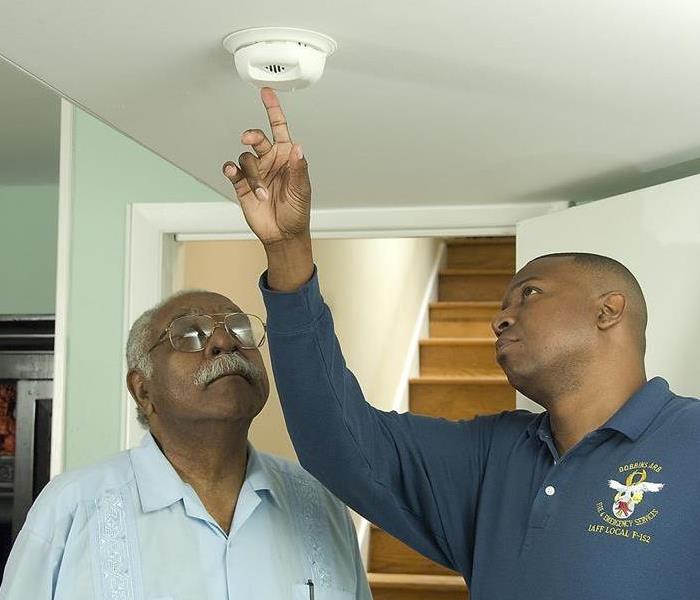 Smoke Alarm Inspection
Smoke Alarm Inspection
Did you know that older adults have a 2.6 times greater risk of dying in a fire than the U.S. population as a whole? The reasons for this staggering statistic are numerous, but can be attributed to age, health issues and environmental (ie: living alone).
Noted below are some tips for older residents, property managers, landlords and those of us with older family members:
- Discuss your fire escape plan with family and neighbors. Contact your building manager or fire department to discuss your plan if you need extra help escaping.
- If you use a walker or wheelchair, check all exits to be sure that you can go through the doorways.
- If you can’t hear your smoke alarm, consider getting one that has a different sound or one that comes with a bed shaker or strobe light.
- Caregivers should check the smoke alarms of those who are unable to it themselves.
- Never smoke around medical oxygen.
- Use a timer to remind you that you are cooking.
Your risk of dying in a home fire is greater as you get older. Don't take unnecessary risks, follow the tips above to improve your chances of escape or extinguishing a fire before a dangerous situation occurs. Always be well prepared.
For more helpful information... https://www.usfa.fema.gov/prevention/outreach/media/social_toolkits/toolkit_caregivers.html
Heater Fire Safety
2/25/2021 (Permalink)
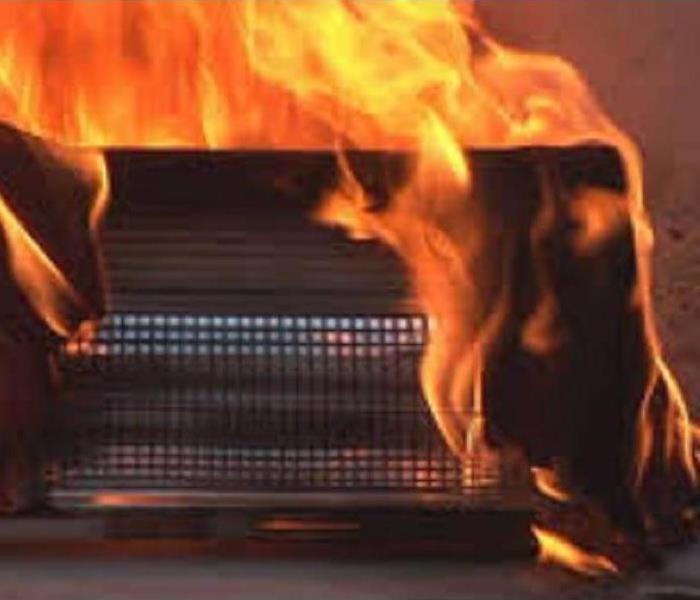 Electrical Heater Fire
Electrical Heater Fire
The unexpected and unseasonal cold weather that hit the midwest and Texas last week has caused massive power outages, which in turn means loss of heat for millions of homeowners and businesses. With no clear end in site, many were turning to alternative heat sources which is a great time for a reminder about safe practice and use of alternative heat sources.
The information noted below is from the U.S. Fire Administration:
Heater Fire Safety
- Make sure your heater has been tested by a recognized testing laboratory.
- Make sure your heater has an automatic shutoff, so if it tips over, it shuts off.
- Keep anything that can burn, like bedding, clothing and curtains, at least 3 feet away from your heater.
- Place space heaters on a solid, flat surface.
- Turn heaters off when you go to bed or leave the room.
For more information, go to https://www.usfa.fema.gov/prevention/outreach/heating.html.
Fireplace & Wood Stove Safety
2/25/2021 (Permalink)
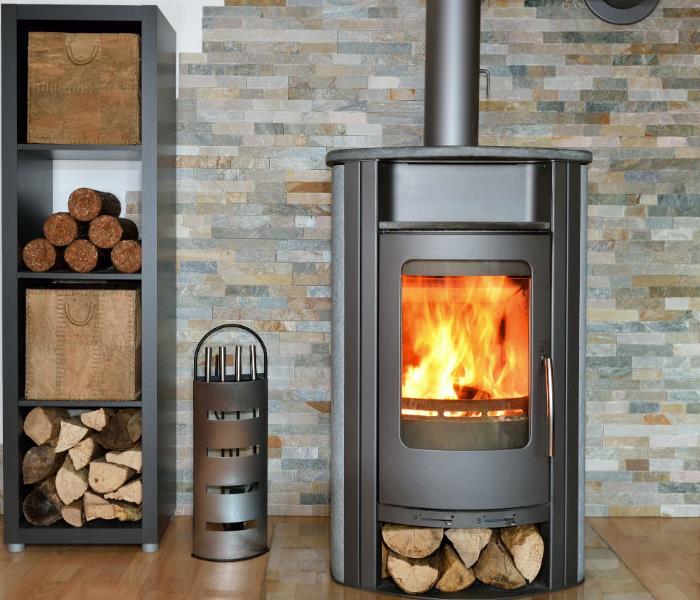 Wood Stove
Wood Stove
Part 2 of our alternative heating safety blog has to do with Fireplace & Wood Stove Safety.
The winters in New England can get pretty cold, and along with power outages due to heavy snowfall, many residents utilize fireplaces, wood burning stoves and pellet stoves as a primary source of heat. Other heavy users tend to be tourists that are headed north for skiing and other winter activities. Resting and relaxing with a nice hot cocoa next to a cozy fire is the ideal way to end a fun-filled winter day.
Understanding recommended safety protocols is of the utmost importance in the prevention of fires.
The information noted below is from the U.S. Fire Administration:
Fireplace & Wood Stove Safety
- Keep anything that can burn at least 3 feet from your fireplace or wood stove.
- Do not burn paper in your fireplace or wood stove.
- Put the fire out before you go to sleep or leave your home.
- As the homeowner, you should have your chimney inspected and cleaned each year by a professional.
- Put ashes in a metal container with a lid. Place the container outside at least 10 feet from the home.
For more information, go to https://www.usfa.fema.gov/prevention/outreach/heating.html.
Spontaneous Combustion
1/22/2021 (Permalink)
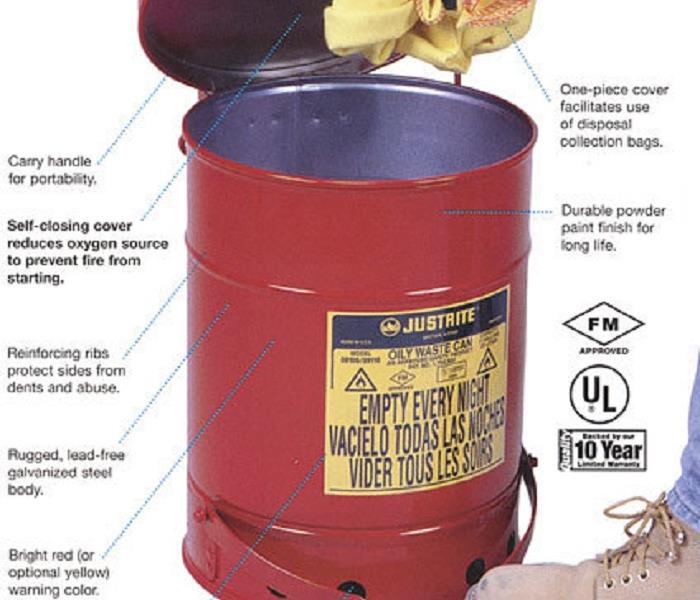 Proper Disposal of Oily Rags
Proper Disposal of Oily Rags
Winter weather outdoors provides for opportunities to perform indoor DIY projects. Renovation of kitchens and baths, change in flooring material, maybe even the addition of cove moldings. Most of these projects require the use of paints, varnishes and stains, of which this blog post is about.
So, what do you do with those used rags covered in oily residue? Place them in the trash? Store them in a bag for disposal? Leave them in a pile? If not disposed of properly, you may be doing more than renovations, you may be rebuilding after setting your house on fire from not storing or disposing of your used stain rags properly.
Oil-based stains are very common with woodworking projects. As oily rags begin to dry, heat is produced. If they're thrown into a pile, oxygen is trapped underneath. The combination of heat, oxygen and the cloth can lead to spontaneous combustion, which results in a fire that could destroy your home.
Don’t think this can happen to you? In Feb of 2020, a GC that was performing construction services for a local school, had a fire in the schools Receiving Area. They were using this area as a shop/storage area while performing their renovation services. The sub-contractor performing the painting/staining services was improperly storing his used stain rags. Fortunately for the GC, the sub-contractor was on site when the fire broke out. They were able to get the local fire department there quickly to extinguish the fire before much damage could be done.
However, the soot from the items that did get burnt penetrated a large area, including the kitchen, causing a substantial loss of food products as well as food prep and food service items. The clean-up needed to remove the soot and odor from the parts of the facility affected was substantial.
Noted below are some tips to help prevent this from happening to you:
- Keep your workspace clean and neat to prevent a fire from spreading and getting bigger.
- The preferred method of storage of oily soaked rags is within a metal container, with a lid, kept away from other potential fuel sources.
- Filling the storage container with water prevents oxidation from the oils.
- Contact your Municipality for proper disposal instructions of your oily rags.
Safety always comes first. Take a few minutes to read the labels of the products you’re using. Understand the safety instructions so that you are prepared to act in the event of an emergency. Read and follow the instructions on proper storage and disposal.
When and How to Use a Fire Extinguisher
2/25/2020 (Permalink)
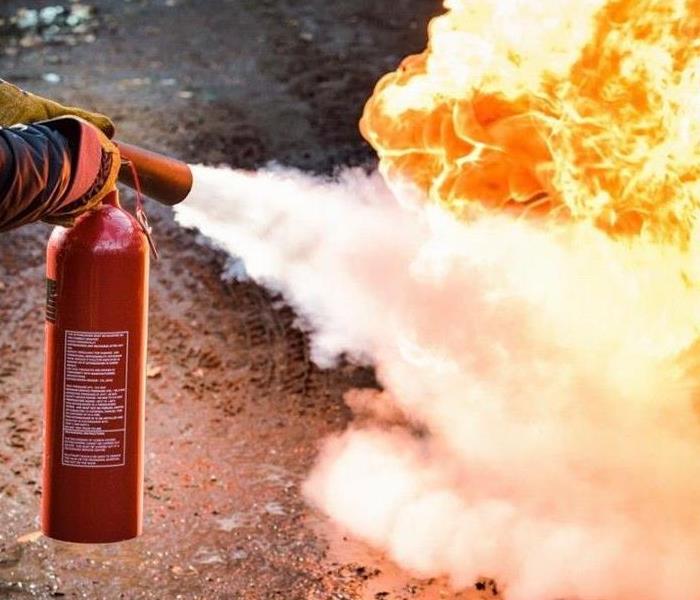 Fire Extinguisher
Fire Extinguisher
Always put your safety first; if you are not confident in your ability to use a fire extinguisher, get out and call 9-1-1. The American Red Cross cautions you to evaluate the situation and ensure:
- Everyone has left or is leaving the home
- The fire department has been called
- The fire is small, not spreading, and there is not much smoke
- Your back is to an exit you can use quickly
Learn about the different types of fire extinguishers; not all will work on every fire. For home use, the National Fire Protection Association recommends a multi-purpose device large enough to put out a small fire but not so heavy that it will be difficult to handle.
Review the instructions once a year. If you need to use a fire extinguisher, there won’t be time to learn how to do it.
To use a fire extinguisher, remember the acronym PASS:
- Pull the pin.
- Aim low at the base of the fire.
- Squeeze the handle slowly.
- Sweep the nozzle side to side.
Resource: National Safety Council
Home Heating Safety
2/25/2020 (Permalink)
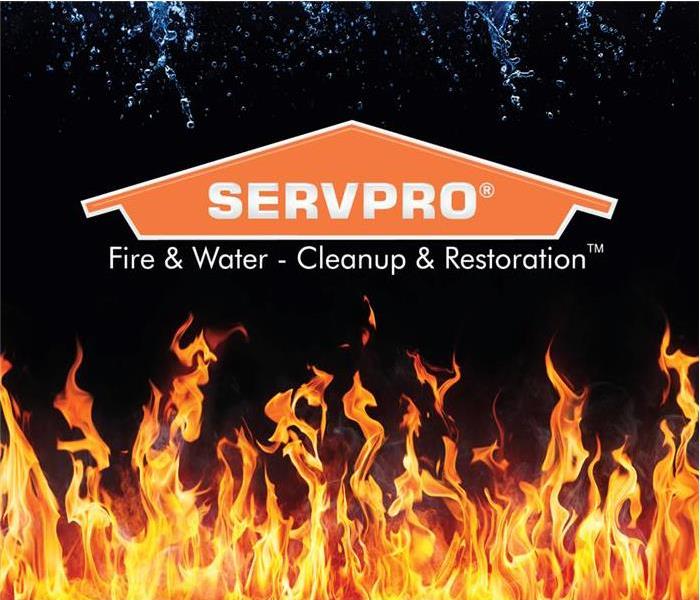 SERVPRO Fire Restoration
SERVPRO Fire Restoration
There is something about the winter months and curling up with a good book by the fireplace. But did you know that heating equipment is one of the leading causes of home fire deaths? With a few simple safety tips and precautions you can prevent most heating fires from happening.
Be warm and safe this winter!
• Keep anything that can burn at least three-feet away from heating equipment, like the furnace, fireplace, wood stove, or portable space heater.
• Have a three-foot “kid-free zone” around open fires and space heaters.
• Never use your oven to heat your home.
• Have a qualified professional install stationary space heating equipment, water heaters or central heating equipment according to the local codes and manufacturer’s instructions.
• Have heating equipment and chimneys cleaned and inspected every year by a qualified professional.
• Remember to turn portable heaters off when leaving the room or going to bed.
• Always use the right kind of fuel, specified by the manufacturer, for fuel burning space heaters.
• Make sure the fireplace has a sturdy screen to stop sparks from flying into the room. Ashes should be cool before putting them in a metal container. Keep the container a safe distance away from your home.
• Test smoke alarms at least once a month.
FACT
Half of home heating fires are reported during the months of December, January, and February.
Resource: National Fire Protection Assc.
Kerosene Heater Safety
12/3/2019 (Permalink)
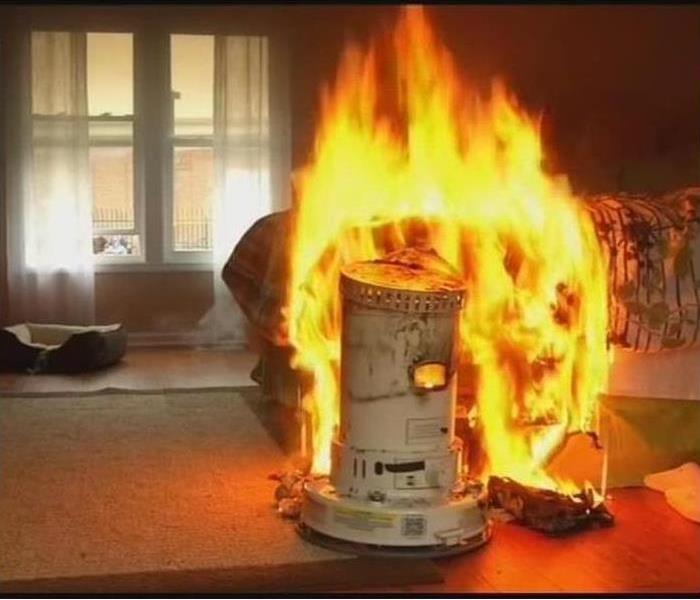 Kerosene Heater on Fire
Kerosene Heater on Fire
Kerosene Heater Safety
Kerosene heaters are often used as a supplemental heat source. They are reasonable priced, kerosene is easily accessible, and kerosene is a clean burning fuel. However, like any fuel source, there are safety rules that should be followed to minimize risk of fire.
1. Use only water-clear 1-K grade kerosene.
2. Always store kerosene in a container intended for kerosene.
3. Purchase from a dealer who can certify that what is being sold is 1-K grade kerosene.
4. Never refuel the heater inside the home.
5. Do not refuel the heater when it is hot or in operation.
6. In case of flare-up or if uncontrolled flaming occurs, do not attempt to move or carry the heater.
7. Reduce your exposure to indoor air pollutants by properly operating and maintaining your portable kerosene heater.
8. Always operate your heater according to the manufacturer:s instructions.
9. Keep the wick in your heater clean and in good operating condition.
10. Keep an outside window opened approximately an inch to ensure adequate fresh air infiltration.
For more safety information, check out the NASD Kerosene Heater Safety recommendations at http://nasdonline.org/1295/d001100/kerosene-heater-safety.html.
Turkey Deep Fry Safety Tips
11/27/2019 (Permalink)
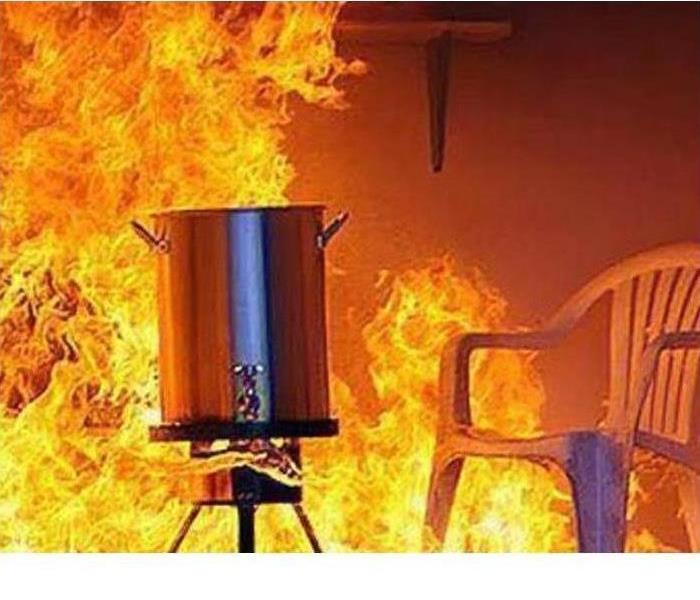 Fire Safety When Deep Frying
Fire Safety When Deep Frying
Turkey Deep Fry Safety Tips
Deep frying a turkey for Thanksgiving? Know the rules of safety so that you and your family can enjoy the feast.
1. Set up your deep fryer outside and at least 10' away from any object (ie: vehicles, house, garage, overhanging limbs, etc...) and out of the wind.
2. Test your connections on your deep fryer and propane tank for leaks by using a simple solution of soapy water.
3. Make sure your turkey is completely thawed and patted dry.
4. Keep a working fire extinguisher on hand and nearby in the event of an emergency.
5. Fill deep fryer with water, then insert turkey to determine fill line. Remove turkey, drain water, then fill fryer to water line with oil. Remember to dry your turkey off again.
6. Be sure to wear your PPE gear before placing turkey in oil. An apron, goggles and gloves (neoprene works best) are recommended.
7. Insert turkey slowly and gently into hot oil.
8. Use a thermometer to ensure correct temps when cooking.
9. Never leave fryer unattended.
10. When turkey is done, shut off burner and remove slowly, using a drip pan to capture any dripping oil.
11. Allow oil to cool and dispose of accordingly.
From all of us at SERVPRO of Derry/Londonderry, have a safe and Happy Thanksgiving!
Smoke and Soot Cleanup
3/3/2018 (Permalink)
Smoke and soot is very invasive and can penetrate various cavities within your home, causing hidden damage and odor. Our smoke damage expertise and experience allows us to inspect and accurately assess the extent of the damage to develop a comprehensive plan of action.
Smoke and soot facts:
- Hot smoke migrates to cooler areas and upper levels of a structure.
- Smoke flows around plumbing systems, seeping through the holes used by pipes to go from floor to floor.
- The type of smoke may greatly affect the restoration process.
Different Types of Smoke
There are two different types of smoke–wet and dry. As a result, there are different types of soot residue after a fire. Before restoration begins, SERVPRO of Derry Londonderry will test the soot to determine which type of smoke damage occurred. The cleaning procedures will then be based on the information identified during pretesting. Here is some additional information:
Wet Smoke – Plastic and Rubber
- Low heat, smoldering, pungent odor, sticky, smeary. Smoke webs are more difficult to clean.
Dry Smoke – Paper and Wood
- Fast burning, high temperatures, heat rises therefore smoke rises.
Protein Fire Residue – Produced by evaporation of material rather than from a fire
- Virtually invisible, discolors paints and varnishes, extreme pungent odor.
Our Fire Damage Restoration Services
Since each smoke and fire damage situation is a little different, each one requires a unique solution tailored for the specific conditions. We have the equipment, expertise, and experience to restore your fire and smoke damage. We will also treat your family with empathy and respect and your property with care.
Have Questions about Fire, Smoke, or Soot Damage?
Call Us Today – SERVPRO of Derry Londonderry (603) 432-3221
Space Heater Safety
1/31/2018 (Permalink)
In the colder months of the year, homeowners look for ways to make chilly areas warm and comfortable. While space heaters can be useful to keep small areas warm, it’s very important to use them with caution. In a 2010 study, it was found that space heaters caused 32 percent of all home heating fires but were involved in 79 percent of all home-heating related fire deaths. Fortunately, using a space heater can be safe if you follow these simple recommendations.
NFPA offers the following safety tips.
Heating
- Have a three-foot “kid-free zone” around open fires and space heaters.
- Supervise children when a fireplace, fire pit, or other space heater is being used. Use a sturdy, metal screen to prevent contact burns, which are even more common than flame burns.
- All heaters need space. Keep things that can burn, such as paper, bedding or furniture, at least 3 feet away from heating equipment.
- Use heating equipment that has the label of a recognized testing laboratory.
- Never use your oven for heating.
- Install stationary space heating equipment, water heaters or central heating equipment, according to the local codes and manufacturer’s instructions.
- Have a qualified professional install the equipment.
- Make sure all fuel-burning vented equipment is vented to the outside to avoid carbon monoxide poisoning. CO is created when fuels burn incompletely. CO poisoning can cause illness and even death. Make sure the venting for exhaust is kept clear and unobstructed. This includes removal of snow and ice around the outlet to the outside.
- Install and maintain carbon monoxide alarms to avoid risk of carbon monoxide poisoning.
- Maintain heating equipment and chimneys by having them cleaned and inspected annually by a qualified professional.
Portable electric space heaters
- Turn heaters off when you go to bed or leave the room.
- Use and purchase portable space heaters with an automatic shut off so if they’re tipped over they will shut off.
- Place space heater on solid, flat surface.
- Plug power cords directly into outlets and never into an extension cord.
- Inspect for cracked or damaged, broken plugs or loose connections. Replace before using.
Fuel burning space heaters
- Always use the proper fuel as specified by the manufacturer.
- When refueling, allow the appliance to cool and refuel outside or in a well-ventilated area.
- When using the heater, open a window to ensure proper ventilation.
- In portable kerosene or other liquid-fueled space heaters, always use the proper grade of the proper fuel.
- All new unvented gas-fired space heaters have an oxygen depletion sensor that detects a reduced level of oxygen in the area where the heater is operating and shuts off the heater before a hazardous level of carbon monoxide accumulates. If you have an older heater without this feature, replace it.
- If the pilot light of your gas heater goes out, allow 5 minutes or more for the gas to go away before trying again, do not allow gas to accumulate, and light the match before you turn on the gas to the pilot to avoid risk of flashback.
- If you smell gas in your gas heater, do not attempt to light the appliance. Turn off all the controls and open doors and window. Call a gas service person.
Wood burning stoves
- Install the stove, chimney connectors and chimneys following manufacturer’s instructions or have a professional do the installation.
- Wood stoves should bear the label of a recognized testing laboratory.
- In wood stoves, burn only dry, seasoned wood. In pellet stoves, burn only dry, seasoned wood pellets.
- Start the fire with newspaper or kindling, never with a flammable liquid, such as lighter fluid, kerosene or gasoline.
- Keep the doors of your wood stove closed unless loading or stoking the live fire.
- Allow ashes to cool before disposing. Dispose of ashes in a tightly covered metal container and keep the ash container at least 10 feet away from the home and any other nearby buildings. Douse and saturate with water.
- Chimneys and vents need to be cleaned and inspected at least once a year.
SERVPRO of Derry Londonderry is here to help you recover from any fire. Our trained technicians will remove the smoke and soot from your home. Saving your belongings and memories. Call your neighbors when you need us 603-432-3221.
Stay Safe this Holiday Season
12/22/2017 (Permalink)
 Holiday Fire Safety
Holiday Fire Safety
Statistics from the National Fire Protection Association (NFPA) show the holidays are a high-risk time for home fires. Christmas trees are responsible for 240 home fires each year, and other holiday decorations are the cause of another 1,170 fires.
Here are some tips to keep your home safe this holiday season:
•Check the stand daily to make sure that the level of water does not go below the base of the tree.
•Keep trees at least three feet away from major sources of heat (fireplaces, heaters, heat vents, and direct sunlight). Lowering the room temperature will slow the drying process.
•Use lights that produce low heat, such as miniature lights, to reduce drying of the tree.
•Always inspect light sets before placing them on the tree. If worn, replace with a new set.
•Do not overload electrical circuits.
•Always turn off the tree lights when leaving the house or when going to bed.
•Monitor the tree for freshness. After Christmas or if the tree is dry, remove it from the house.
•Install and ensure smoke alarms work inside and outside each bedroom and sleeping area. Install alarms on every level of the home, including the basement.
If you have a fire, call SERVPRO of Derry Londonderry. We are available 24/7 and only one call away 603-432-3221. We make it like it never even happened!!
Thanksgiving Safety
11/15/2017 (Permalink)
 Use Safe Cooking Practices at Thanksgiving
Use Safe Cooking Practices at Thanksgiving
For most, the kitchen is the heart of the home, especially during the holidays. From testing family recipes to decorating cakes and cookies, everyone enjoys being part of the preparations.
So keeping fire safety top of mind in the kitchen during this joyous but hectic time is important, especially when there’s a lot of activity and people at home. As you start preparing your holiday schedule and organizing that large family feast, remember, by following a few simple safety tips you can enjoy time with your loved ones and keep yourself and your family safer from fire.
Thanksgiving by the numbers
- Thanksgiving is the peak day for home cooking fires, followed by Christmas Day and Christmas Eve.
- In 2015, U.S. fire departments responded to an estimated 1,760 home cooking fires on Thanksgiving, the peak day for such fires.
- Unattended cooking was by far the leading contributing factor in cooking fires and fire deaths.
- Cooking equipment was involved in almost half (48%) of all reported home fires and civilian and tied with heating equipment for the second leading cause of home fire deaths
Safety tips
- Stay in the kitchen when you are cooking on the stovetop so you can keep an eye on the food.
- Stay in the home when cooking your turkey and check on it frequently.
- Keep children away from the stove. The stove will be hot and kids should stay 3 feet away.
- Make sure kids stay away from hot food and liquids. The steam or splash from vegetables, gravy or coffee could cause serious burns.
- Keep the floor clear so you don’t trip over kids, toys, pocketbooks or bags.
- Keep knives out of the reach of children.
- Be sure electric cords from an electric knife, coffee maker, plate warmer or mixer are not dangling off the counter within easy reach of a child.
- Keep matches and utility lighters out of the reach of children — up high in a locked cabinet.
- Never leave children alone in room with a lit candle.
- Make sure your smoke alarms are working. Test them by pushing the test button.
More NFPA Thanksgiving-related information
If you do have a kitchen fire SERVPRO Derry Londonderry is here to get your family back to cooking!! Our professional and experienced teams will remove the smoke, soot and fire damage from your home. Even a small kitchen fire can leave a residue and odor. Call SERVPRO Derry Londonderry at 432-3221 to get your home back in it's best condition for the holidays!!

 24/7 Emergency Service
24/7 Emergency Service









